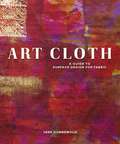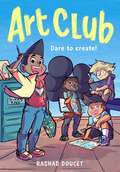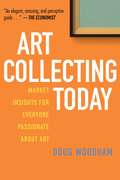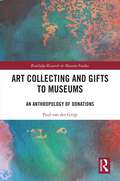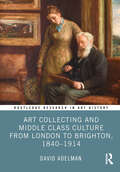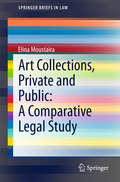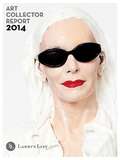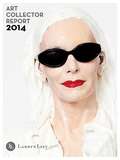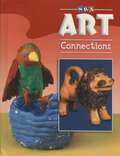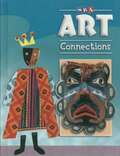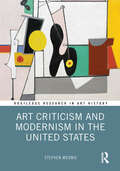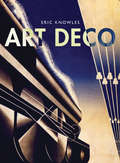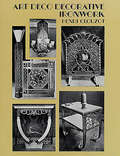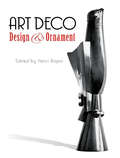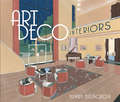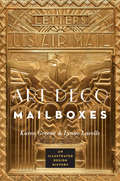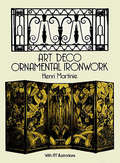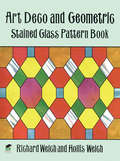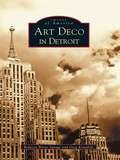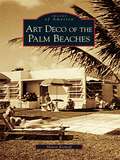- Table View
- List View
Art Cities Of The Future: 21st-Century Avant-Gardes
by Reid Shier Antawan I. Byrd Geeta Kapur Kaelen Wilson-GoldieIn the 1990s a quiet revolution began. Contemporary art, for decades an enterprise dominated by a relatively small number of individuals - artists, dealers, collectors, curators and critics based in three or four cities - gradually became global. Biennials sprang up in every corner of the world just as cheap airfares began to shrink the distances between them. Emerging technologies opened up new lines of communication, and international publishers launched contemporary art lists. Meanwhile art fairs grew and multiplied, creating a movable feast with regular stops on every continent. Today the art world is more of a world in every sense, with a larger population, a wider territory and a greater number of nationalities. Its prevailing conversation, however, has yet to catch up. This conversation, still shaped by the belief that artistic progress stems from the avant-garde - a cohesive group with a common lineage, all grappling with a shared set of artistic issues - risks overlooking the real breakthroughs taking place all around us. Art Cities of the Future uncovers twelve distinct avant-gardes that have emerged around the world in recent decades. Twelve curators each select eight artists to represent the avant-garde of a specific city. These artists may be senior figures or newer faces, artists working in familiar mediums or inventing their own, but they all share two qualities- a commitment to experimental art and a dedication to their local milieu. These twelve cities are art's next capitals, and from this batch of 96 artists will emerge tomorrow's stars - the future heroes of art history and the market's next blue-chip investments.
Art Cloth
by Jane DunnewoldThis information-packed handbook is appropriate for both newcomers and experienced dyers but assumes that readers have a serious interest in textile design.
Art Cloth
by Jane DunnewoldThis information-packed handbook is appropriate for both newcomers and experienced dyers but assumes that readers have a serious interest in textile design.
Art Club (A Graphic Novel)
by Rashad DoucetInspired by the author&’s own childhood, this contemporary graphic novel paints a picture of an aspiring young artist on a mission to prove that the arts are worth fighting for. Dale Donavan has heard the same lecture over and over again: Art will get you nowhere in life. A kid with a creative streak, Dale wants nothing more than to doodle, play video games, and create comics forever—maybe even as a full-time job one day. But between his grandfather pushing him to focus on his studies and a school with zero interest in funding arts programs, Dale feels like his future has already been decided for him. That is, until he comes up with the perfect plan: What if he starts an after-school art club, gathers a team of creative students like himself, and proves all the naysayers—his stubborn vice principal in particular—wrong? This might just work, but if the club isn&’t financially successful by the end of the semester, the school with shut them down. This may be Dale&’s only chance to show the adults in his life that a career as an artist is not just a dream but a possibility!
Art Collecting Today: Market Insights for Everyone Passionate about Art
by Doug WoodhamAn insider's guide to buying, collecting, and selling art from an insider of Christie's Grounded in real-life stories, Art Collecting Today is the essential practical guide to today's art market. A lightly regulated industry with more than sixty billion dollars of annual sales, the art market is often opaque and confusing to even the most experienced collectors. But whether a seasoned collector, an uninitiated newcomer, or an art-world insider, readers will learn within these pages how the art marketplace works in practice and how to navigate it smartly. Those who may have been put off by art-world practices will finally feel they have the knowledge needed to participate freely and fully, and collectors will be able to pursue their passion with more confidence. Important topics covered include:How to evaluate, buy, and sell art while avoiding costly mistakes and time-consuming roadblocks How the market works in practice for essential artists like Ren? Magritte, Christopher Wool, Amedeo Modigliani, and Yayoi Kusama How collectors can be taken advantage of, and the actions they should take to protect themselves Why tax laws in the United States reward "art investors" yet penalize "art collectors" How cultural property laws impact the market for works by such artists as Frida Kahlo and Andy Warhol Advice for new and prospective collectors Informed by close to one hundred interviews with collectors, lawyers, art advisors, gallerists, and auction specialists in the United States and Europe, as well as by the author's own experiences, Art Collecting Today offers a lively and thought-provoking analysis of the day-to-day workings at play today in the fine art marketplace.
Art Collecting and Gifts to Museums: An Anthropology of Donations (Routledge Research in Museum Studies)
by Paul van der GrijpArt Collecting and Gifts to Museums questions why private collectors donate their collection, or parts of it, to museums and examines what the implications of this gifting process might be.Presenting case studies from Europe, North America, East Asia, and the South Pacific, this book is concerned with both elite and popular collections and examines the act of donating art from the collector’s point of view. Demonstrating that art museums depend on donations from private collectors, Paul van der Grijp emphasizes that it is crucial to understand the psychological, sociological, economic, and educational motivations for gifting works of art to institutions. Taken together, the chapters argue that collectors donate to museums because the latter represent an imagined community, to whom those collectors would like to bestow a sacred gift. Private collectors are, Van der Grijp maintains, motivated to ensure the immortality of their collections and, ultimately, to preserve some memory of their own lives in the process.Art Collecting and Gifts to Museums will be of interest to researchers and students engaged in the study of museums, culture, art, anthropology, history, and sociology.
Art Collecting and Middle Class Culture from London to Brighton, 1840–1914 (Routledge Research in Art History)
by David AdelmanThis study explores the interplay between money, status, politics and art collecting in the public and private lives of members of the wealthy trading classes in Brighton during the period 1840–1914.Chapters focus on the collecting practices of five rich and upwardly mobile Victorians: William Coningham (1815–84), Henry Hill (1813–82), Henry Willett (1823–1905) and Harriet Trist (1816–96) and her husband John Hamilton Trist (1812–91). The book examines the relationship between the wealth of these would-be members of the Brighton bourgeoisie and the social and political meanings of their art collections paid for out of fortunes made from sugar, tailoring, beer and wine. It explores their luxury lifestyles and civic activities including the making of Brighton museum and art gallery, which reflected a paradoxical mix of patrician and liberal views, of aristocratic aspiration and radical rhetoric. It also highlights the centrality of the London art world to their collecting facilitated by the opening of the London to Brighton railway line in 1841.The book will be of interest to scholars working in art history, museum studies and British history.
Art Collections, Private and Public: A Comparative Legal Study (SpringerBriefs in Law)
by Elina MoustairaThis book is a comparative legal study of the private and public art collections in various states of the world, covering the most important issues that usually arise and focusing on the differences and the similarities of the national laws in the treatment of those issues.
Art Collector Report
by Larry'S ListThe Larry's List team consists of art market researchers from around the world. Currently, we have more than 20 nationalities, each researcher with a background in art history or experience with art dealing.Which city in the world has the highest density of 2014 contemporary art collectors? Which country?Why does Germany almost have as many private art museums as the us?And what are the future trends for the global collectors scene?What you get: Unique Information on Art Collectors! The report offers detailed information on leading art collectors around the world. Our researchers carefully selected the data manually.
Art Collector Report KINDLE EDITION
by Larry'S ListThe Larry's List team consists of art market researchers from around the world. Currently, we have more than 20 nationalities, each researcher with a background in art history or experience with art dealing.<P><P>Which city in the world has the highest density of 2014 contemporary art collectors? Which country?Why does Germany almost have as many private art museums as the us?And what are the future trends for the global collectors scene?What you get: Unique Information on Art Collectors! The report offers detailed information on leading art collectors around the world. Our researchers carefully selected the data manually.
Art Connections (Level #2)
by McGraw-HillArtists make art about many subjects. Subject matter is the content of an artist's work. For example, the subject of a painting can be a vase of flowers or a self-portrait. This subject matter is easy to see. The subject matter is harder to understand when the artwork stands for something beyond itself.
Art Connections (Level #6)
by McGraw-HillThis textbook is about art, its history and culture, aesthetic perception, art criticism, etc.
Art Criticism and Modernism in the United States (Routledge Research in Art History)
by Stephen MoonieThis study is an analysis of 'high' and 'late' modernist criticism in New York during the 1960s and early 1970s. Through a close reading of a selection of key critics of the period—which will expand the remit beyond the canonical texts—the book examines the ways that modernist criticism’s discourse remains of especial disciplinary interest. Despite its alleged narrowness and exclusion, the debates of the 1960s raised fundamental questions concerning the nature of art writing. Those include arguments around the nature of value and judgement; the relationship between art criticism and art history; and the related problem of what we mean by the ‘contemporary.’ Stephen Moonie argues that within those often-fractious debates, there exists a shared discourse. And further, contrary to the current consensus that modernists were elitist, dogmatic, and irrelevant to contemporary debates on art, the study shows that there is much that we can learn from reconsidering their writings. The book will be of interest to scholars working in art history, modern art, art criticism, and literary studies.
Art Deco
by Eric KnowlesAlthough most associated with the 1920s and 30s, Art Deco began in France prior to World War I. During the interwar years the style evolved and was adopted by an international elite set as the perfect expression of modern opulence and elegance in an age that gave birth to jazz, the Charleston, speakeasies, glamorous Hollywood films and engineering marvels such as skyscrapers. At the height of its popularity the Art Deco influence was seen in a wide variety of remarkable and innovative applications from decorative arts such as jewelry, metalwork, ceramics, and glass to massive scale applications in architecture, interior design, fashion, public works projects and consumer goods from automobiles to telephones to jukeboxes. This unique book is a collection of the most beautiful examples of Art Deco style from personal statements in jewelry to skyscrapers that defined city skylines, and examines the social and cultural climates of the 1920s and 30s which were perfectly aligned with the optimism and elegance of Art Deco. It traces the seminal influences in its evolution including the Ballets Russes, Cubism and the Bauhaus and explains why Art Deco style continues to attract new collectors and enthusiasts who connect with this design styles' impeccable ability to convey opulence, elegance, and exclusivity.
Art Deco Decorative Ironwork (Dover Jewelry and Metalwork)
by Henri ClouzotSumptuous treasury of 320 lavish examples of architectural ornamentation from the 1920s and '30s by Paul Kiss, Raymond Subes, Edgar Brandt and other artisans. Meticulously reproduced photographs from three rare portfolios depict magnificent designs for doors, grilles, gates, lamps, balustrades, chandeliers, screens, mirrors, and other objects.
Art Deco Design and Ornament
by Henri RapinA major design movement of the 1920s and 1930s, Art Deco drew its strength from architecture, modern art, primitivism, and industry. It gave us the Chrysler Building and Soviet post art -- and also gave us a legacy that continues to pulse with energy and excitement even today.In this rich collection of 349 images, the Art Deco style is evident in every draping vine, languid curve, bulging muscle, and geometric figure. It will leap out at you from friezes, plaques, sculpture, vases, doorways, tiles, furniture, arches, and more.It's a splendid book for anyone interested in the arts -- and for artists and craftsmen, a genuine wellspring of artistic ideas.
Art Deco Interiors
by Henry DelacroixFirst published in Paris as Decoration Moderne dans l'Interieur, this rare 1935 portfolio of full-color plates reflects the influence of Art Deco modernism on architects and interior designers. Designs for every space include living rooms, dining rooms, bedrooms, bathrooms, offices, terraces, artists' studios, and other settings. Equally eye-catching are the lighting, chairs, tables, beds, bookcases, desks, accessories, and other furniture along with floor and wall treatments and additional elements of modernist interior design. Captions identify the creator of every design, and the book includes a translation of the original Introduction and a new Publisher's Note. This splendid collection of authentic, hard-to-find designs will provide a treasury of inspiration for architects, interior designers, and designers of furniture and accessories as well as collectors of authentic Art Deco material and students of design, architectural history, and popular culture.
Art Deco Mailboxes: An Illustrated Design History
by Lynne Lavelle Karen GreeneA great gift book for lovers of unsung urban decorative art and unique architectural details. Mailboxes and their chutes were once as essential to the operation of any major hotel, office, civic, or residential building as the front door. In time they developed a decorative role, in a range of styles and materials, and as American art deco architecture flourished in the 1920s and 1930s they became focal points in landmark buildings and public spaces: the GE Building, Grand Central Terminal, the Woolworth Building, 29 Broadway, the St. Regis Hotel, York & Sawyer’s Salmon Tower, the Waldorf Astoria, and many more. While many mailboxes have been removed, forgotten, disused, or painted over (and occasionally repurposed), others are still in use, are polished daily, and hold a place of pride in lobbies throughout the country. A full-color photographic survey of beautiful early mailboxes, highlighting those of the grand art deco period, together with a brief history of the innovative mailbox-and-chute system patented in 1883 by James Cutler of Rochester, New York, Art Deco Mailboxes features dozens of the best examples of this beloved, dynamic design’s realization in the mailboxes of New York City as well as Chicago, Philadelphia, Indianapolis, Cincinnati, and beyond.
Art Deco Ornamental Ironwork (Dover Jewelry and Metalwork)
by Henri MartinieNearly 200 beautiful examples of wrought iron gates, screens, balustrades, and other architectural adornments.
Art Deco Spot Illustrations and Motifs: 513 Original Designs (Dover Pictorial Archive)
by William RoweThe sleek, exciting geometric motifs seen everywhere in today's decorative arts reflect the continuing Art Deco revival. Textiles, wallpaper, upholstery, and graphics abound with the dynamic, distinctive patterns associated with this influential and popular style.Now artists, designers, and craftspeople can have a treasury of original Art deco compositions at their fingertips -- ready for use in any graphic project. This volume includes over 500 crisp black-and-white spot illustrations and motifs combining stylized birds, insects, and floral elements with circles, squares, ovals, triangles, and other abstract forms. Best of all, they're copyright-free . . . no prior permission or fee is required for use. Remarkably inventive and versatile, William Rowe's masterful Art Deco renderings are perfect for highlighting advertisements, greeting cards, menus, catalogs and invitations, or for adding graphic vitality to fabric designs, stationery, bookplates, and a host of other arts and crafts undertakings. You'll find Art Deco Spot Illustrations and Motifs ideal for your needs whether your project calls for an entire illustration or just a single motif. Designers, illustrators, and craft enthusiasts will want to keep this time-saving, money-saving collection on hand as an inexhaustible source of inspiration with fresh Art Deco flavor.
Art Deco Tiles
by Hans LemmenArt Deco is arguably the twentieth century's most popular and memorable design movements. The style defined the interwar period with its clean sleek lines, streamlined shapes, bold abstract forms, and luscious colours.This book charts the impact of this daring new style on the production of tiles and architectural faience in Britain. It shows how they were made and decorated, examines the output of firms like Carter, Pilkington's and Doulton and describes the innovations introduced by creative designers like Edward Bawden and Dora Batty.With photographs of the tiles and architectural faience, individually and in situ of buildings and homes, the author examines the diverse range of animal, floral, human and abstract Art Deco designs.
Art Deco and Geometric Stained Glass Pattern Book
by Hollis Welch Richard WelchIf you love the bold, exciting look of Art Deco designs, this treasury of stylish patterns is certain to inspire you toward new heights in your stained glass and other craft projects. These patterns in the streamlined Art Deco style include a wealth of workable motifs with an imaginative geometric flair.Ovals, ellipses, rectangles, triangles, circles, and numerous other figures are incorporated here in inventive configurations. The patterns, some even suggesting optical illusions, are ideal for windows, sidelights, transoms, lampshades, and a host of other stained glass projects.
Art Deco in Detroit
by Greg Kowalski Rebecca Binno SavageSince the 1920s, Art Deco, or "The Modern Style," has delighted people with its innovative use of materials and designs that capture the spirit of optimism to create the style of the future. Although the Detroit metro area is primarily known as an industrial region, it boasts some of the finest examples of Art Deco in the country. Art Deco in Detroit explores the wide-ranging variety of these architectural marvels, from world-famous structures like the Fisher and Penobscot Buildings, to commercial buildings, theaters, homes, and churches. Through a panorama of photographs, authors Rebecca Binno Savage and Greg Kowalski take readers on a fascinating tour of this influential movement and its manifestations in and around Detroit. The grandeur evident in some of the major buildings reflects a time when artisans and architects collaborated to craft structures that transcend functionality-they endure as standing works of art.
Art Deco of the Palm Beaches
by Sharon KoskoffArt Deco design is a jazzy celebration of the Machine Age, mass production, geometry, and the straight line. In Palm Beach County, sleek themes are seen representing tropical, nautical, masculine, and stylized motifs that reflect speed and technology. Elements include eyebrows, flat roofs, porthole windows, rounded corners, columns, glass blocks, bandings, multiples of three, and Zig-Zag steps. Palm Beach County has dozens of Art Deco treasures built throughout the 1920s, 1930s, and 1940s, which are located in the downtowns of Delray Beach up through West Palm Beach. Art Deco architecture found in Palm Beach County is spread out rather than concentrated in one location. These buildings are significant to the history of South Florida because they represent some of the earliest structures ever built in the area. These remarkable gems are in danger of being demolished due to the ever-increasing amount of development throughout the county.

